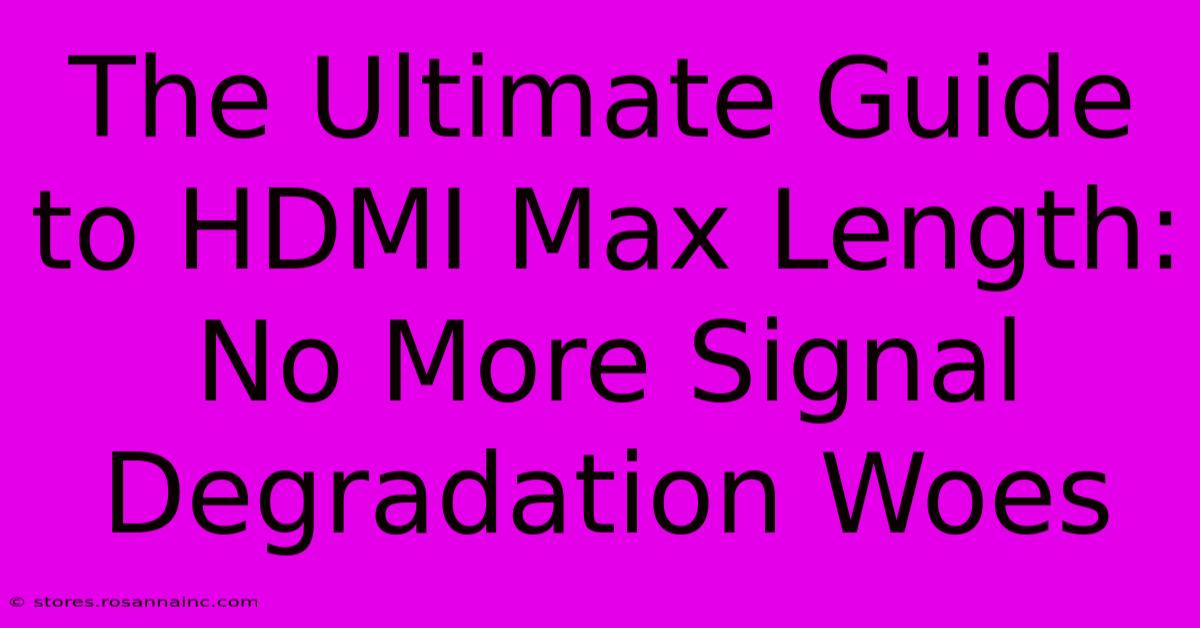The Ultimate Guide To HDMI Max Length: No More Signal Degradation Woes

Table of Contents
The Ultimate Guide to HDMI Max Length: No More Signal Degradation Woes
Are you tired of frustrating signal drops and blurry images when using your HDMI cable? The distance between your source device (like your Blu-ray player or gaming console) and your display (TV, projector) can significantly impact picture quality. This ultimate guide will demystify HDMI cable length limitations and equip you with the knowledge to choose the right cable and avoid those pesky signal degradation woes.
Understanding HDMI Signal Limitations
HDMI (High-Definition Multimedia Interface) transmits uncompressed digital audio and video data. While seemingly simple, the longer the cable, the more susceptible it is to signal attenuation – a weakening of the signal that leads to:
- Poor Picture Quality: Blurred images, pixelation, color distortion, and flickering are common symptoms.
- Audio Dropouts: Intermittent sound loss or static.
- No Signal: The most frustrating outcome – your display shows nothing.
The problem isn't simply cable length; it's signal integrity. Standard HDMI cables, while perfectly functional for short distances, aren't designed to handle long runs without signal boosting. The maximum length for a standard HDMI cable depends on the HDMI version and the cable quality, but generally, problems start to appear beyond 15-25 feet (4.5-7.5 meters).
HDMI Versions and Maximum Lengths: A Quick Guide
The HDMI version significantly impacts the maximum cable length before signal degradation becomes noticeable. Higher versions generally offer improved bandwidth and can support longer runs. However, even with newer versions, exceeding recommended lengths often requires additional solutions.
- HDMI 1.x - 2.0: Generally limited to under 25 feet (7.5 meters) without signal loss.
- HDMI 2.1: While capable of higher bandwidth, very long runs still require signal boosters.
Important Note: Stated maximum lengths are often ideal scenarios. Real-world factors like cable quality, connectors, and signal interference can significantly shorten this distance.
Extending Your HDMI Reach: Solutions for Long Distances
Several effective methods exist to overcome HDMI cable length limitations:
1. HDMI Extenders: The Reliable Solution
HDMI extenders use signal boosters or encoders/decoders to maintain signal integrity over long distances. They come in various forms:
- Active HDMI Extenders: These employ active circuitry to amplify the signal, allowing for significantly longer cable runs (often exceeding 100 feet). They are the most reliable solution for longer distances.
- HDMI Over Cat5e/Cat6 Extenders: These transmit the HDMI signal over standard network cabling, providing flexibility and longer reach.
Choosing an extender: Consider the distance you need to cover and the resolution/bandwidth you require. Look for extenders supporting the highest possible HDMI version for optimal performance.
2. HDMI Over IP Solutions: Wireless Flexibility
For maximum flexibility, especially in situations with difficult cabling, HDMI over IP solutions transmit the signal over a network. This allows you to extend your display over long distances wirelessly or through existing network infrastructure. However, this approach usually requires a more significant investment.
3. Fiber Optic HDMI Cables: For the Longest Runs
Fiber optic HDMI cables transmit signals using light, offering superior signal integrity and supporting much longer distances than standard copper cables. This is the premium option but might be costly.
Troubleshooting HDMI Signal Issues
Before investing in extenders or new cables, consider these troubleshooting steps:
- Check Connections: Ensure all HDMI cables are securely connected at both ends. Loose connections are a common cause of signal problems.
- Cable Quality: Use high-quality HDMI cables from reputable brands. Cheap cables are more prone to signal loss.
- Interference: Electronic devices or electromagnetic fields near the cable can interfere with the signal. Try rerouting the cable to minimize interference.
- HDMI Version Compatibility: Ensure your source device, cable, and display all support the same (or compatible) HDMI version.
Choosing the Right HDMI Cable Length: Key Considerations
- Measure Your Distance: Accurately measure the distance between your source and display. Don't underestimate!
- Consider Future Needs: Choose a solution that will accommodate future upgrades and longer distances if necessary.
- Budget: Set a budget and compare options based on performance, reliability, and cost.
By understanding HDMI signal limitations and exploring the available solutions, you can say goodbye to signal degradation and enjoy crystal-clear visuals without compromise. Don't let distance hinder your home theater or gaming experience!

Thank you for visiting our website wich cover about The Ultimate Guide To HDMI Max Length: No More Signal Degradation Woes. We hope the information provided has been useful to you. Feel free to contact us if you have any questions or need further assistance. See you next time and dont miss to bookmark.
Featured Posts
-
The Healing Power Of The Singke White Gerbera Unmasking Its Medicinal Properties
Feb 06, 2025
-
Unleash Your Patriotic Pride Bannersto Enhance Your Military Legacy
Feb 06, 2025
-
Unlock The Power Of Peer Pressure The Astonishing Science Behind Social Facilitation
Feb 06, 2025
-
Bloom With Budget Friendliness Get A Fifty Flowers Coupon Code To Elevate Your Floral Delights
Feb 06, 2025
-
Unlock Your Productivity Discover The Ultimate Temporary Office Space In San Francisco
Feb 06, 2025
